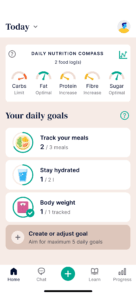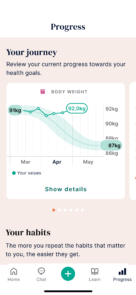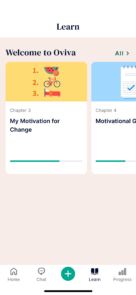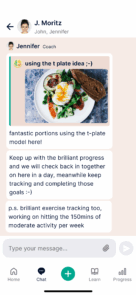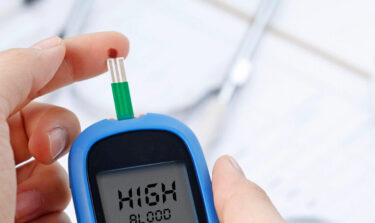
Prediabetes: symptoms, causes and what you can do
Prediabetes doesn’t mean you’ve developed diabetes – it’s a chance to take action before you do and improve your health. With small, realistic changes to your lifestyle, it’s possible to reduce your blood glucose and lower your risk of type 2 diabetes.
Discover what prediabetes is, what blood glucose levels put you in the prediabetes range, plus the steps you can take to lower blood glucose and reduce your risk.
You don’t need to do this alone. If you have pre-diabetes and a BMI over 35, you may be eligible for Oviva’s NHS-funded weight loss programme. You’ll get expert care and a personalised plan to help you lose weight and regain control of your health.
Key Takeaways
- Prediabetes is a warning sign – with the right support, you can take steps to reverse it and lower your risk of type 2 diabetes.
- Losing weight and making positive changes to your nutrition can help return your blood glucose levels to a healthy range.
- Oviva’s expert support can help you implement lifestyle changes and stay on track.
What is prediabetes?
Prediabetes (also called non-diabetic hyperglycaemia) means your blood glucose levels are higher than normal but not high enough to be diagnosed with type 2 diabetes.
It’s an early warning stage when changes to your habits can make a big difference and reduce health risks.
At this point, your body is still producing insulin, the hormone that helps move glucose from your blood into your cells. That’s why making some timely lifestyle changes, like eating differently or moving more, can be so effective.
Think of prediabetes as a yellow traffic light – a signal to slow down, assess where you are, and make a move towards better health.
Symptoms of prediabetes
Prediabetes is usually asymptomatic, meaning it doesn’t produce symptoms. That’s why many people don’t realise they have it.
How do I get diagnosed?
You’re most likely to be diagnosed through a blood test. This might be part of a routine health check, or suggested by your doctor if you’re at higher risk of developing type 2 diabetes.
You might be more at risk if you’re living with overweight or obesity, especially if type 2 diabetes runs in your family.
Some people also notice signs like feeling more tired than usual, but it’s common to have no clear symptoms.
If you’re worried about prediabetes, you can ask your GP for a blood test.

Questions to ask your doctor if you’re diagnosed with prediabetes
If you’re diagnosed with prediabetes, it’s important to ask your GP questions so you can fully understand what it means and what the potential health risks are.
- Your risk factors for type 2 diabetes:
“How close to meeting the threshold for a type 2 diabetes diagnosis am I?”
“Do I have any specific diabetes risk factors I need to be aware of?”
- Follow-up appointments and re-testing:
“How long do I need to wait before I can be retested, and what’s a realistic timeline to reverse prediabetes?”
- How you can reverse your prediabetes diagnosis:
“Based on my specific situation, what are some things I can do to work towards reducing my prediabetes diagnosis?”
If your BMI is 35+, speak to your GP about a a referral to a weight loss solution like Oviva where you’ll get a personalised weight loss plan, your own health coach and access to weight loss injections (if appropriate):
“Am I eligible for a service like Oviva? Can you refer me?”

My blood glucose levels are now at a normal 5.6 – that’s my biggest achievement.
Blood glucose levels for prediabetes
Prediabetes is usually diagnosed when your blood glucose levels are higher than normal, but not high enough for a type 2 diabetes diagnosis.
You may be diagnosed with prediabetes if your results fall within these ranges:
- Fasting blood glucose: 5.6–6.9 mmol/l
- Oral glucose tolerance test (2 hours after glucose drink): 7.8–11.0 mmol/l
- HbA1c (overall blood glucose control over 2-3 months): 42-47 mmol/mol (6.0-6.4%)
The most common test is the HbA1c, which shows your average blood glucose levels over the past few months. It gives your healthcare team a clearer picture of how your body is processing sugar over time.

Health risks linked to prediabetes
Prediabetes means your blood sugar levels are higher than normal, which can put extra strain on your body over time.
Without support, it can increase the risk of developing other health conditions, including:
- Type 2 diabetes
- Heart disease
- Stroke
- Kidney disease
- Dementia
- Circulatory problems
What causes prediabetes?
Insulin resistance
Prediabetes often develops when your body stops responding to insulin properly. This is known as insulin resistance.
Insulin moves glucose from your blood into your cells so it can be used as energy.
When you have insulin resistance, it means your cells are resisting the insulin, so the glucose can’t get into your cells to be used for energy. Instead, glucose stays in your blood.
That’s why, over time, you’ll see your blood glucose levels go up.
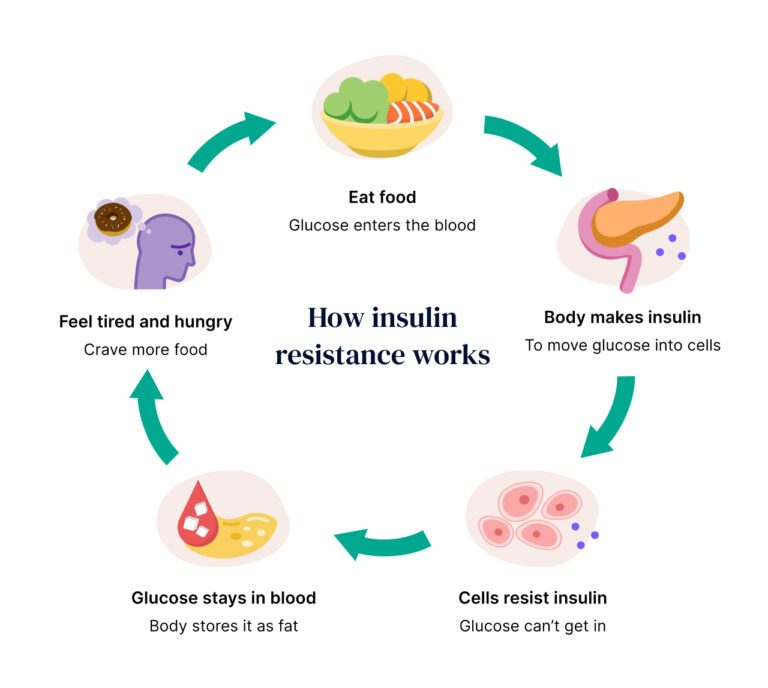
Risk factors that can cause prediabetes
Certain factors can make prediabetes more likely, including:
- Living with overweight or obesity
- Not being physically active
- High blood pressure
- High cholesterol
- A family history of type 2 diabetes
- Past gestational diabetes (diabetes during pregnancy)
- Being over 40 (or over 25 if you’re from a Black African, African Caribbean, or South Asian family background)
Understanding your risk is a positive first step. The earlier prediabetes is identified, the more you can do to support your long-term health.
Can you prevent type 2 diabetes?
Yes – you can still prevent type 2 diabetes.
If you’ve been diagnosed with prediabetes, it means you haven’t yet reached the threshold for a type 2 diabetes diagnosis.
Many people with prediabetes are able to lower their blood glucose levels through lifestyle changes. Your doctor might also discuss medication options, like metformin, if you’re at higher risk of developing type 2 diabetes.
Making small changes now can help prevent type 2 diabetes in the future.
Here are some ways you can get started:

1. Eat a balanced diet
Focus on regular meals with a mix of fibre, lean protein and healthy fats.
Try to reduce how often you have sugary drinks and processed foods.
2. Move more
You don’t need to go to the gym – walking, gardening, housework and dancing to music all count. Find something you enjoy and make it a priority to move more often.
3. Work towards a healthy weight
Even a small amount of weight loss – around 5% of your total body weight – can improve insulin action and lower your blood glucose levels.
If you’re living with excess weight, losing weight is the most effective way to prevent type 2 diabetes.
4. Get support
If you’re living with overweight or obesity, losing weight can be an effective way to reduce your risk of developing type 2 diabetes.
Oviva offers NHS-funded support for people with a BMI over 35 and a weight-related health condition, like prediabetes, who want to make long-term changes to their weight and health.
Our team of dietitians, health coaches and more help you build realistic habits tailored to your lifestyle.
You’ll also get access to the Oviva app where you can set goals, track your progress and get 1-to-1 support.
Can you prevent prediabetes?
Yes, in many cases, prediabetes can be prevented.
While some people have a higher risk due to family history or other factors, there are still steps you can take to lower your risk and support your long-term health.
Here are some ways you can reduce your risk:
- Eat a balanced, nutritious diet
- Work towards a healthy weight (if needed)
- Move your body more often
- Stop smoking

You’re not alone – and it’s not too late
A prediabetes diagnosis can feel scary, but it’s also an opportunity to make positive changes to your health and prevent type 2 diabetes.
If you have a BMI over 35 and a weight-related condition like prediabetes, you could be eligible for Oviva’s NHS-funded weight loss programme.
It’s fully remote through the Oviva app, which means no travelling to appointments and no waiting rooms.
And you’ll access:
- A weight loss plan that’s tailored to you
- 1 to 1 support from your own health coach
- Easy tracking for meals, goals, activities and more
- Weight loss medication delivered to your door (if appropriate)
Speak to your GP to see if you’re eligible. If you are, it’s easy for them to refer you.
Everything you need to get started is in our free info pack!


